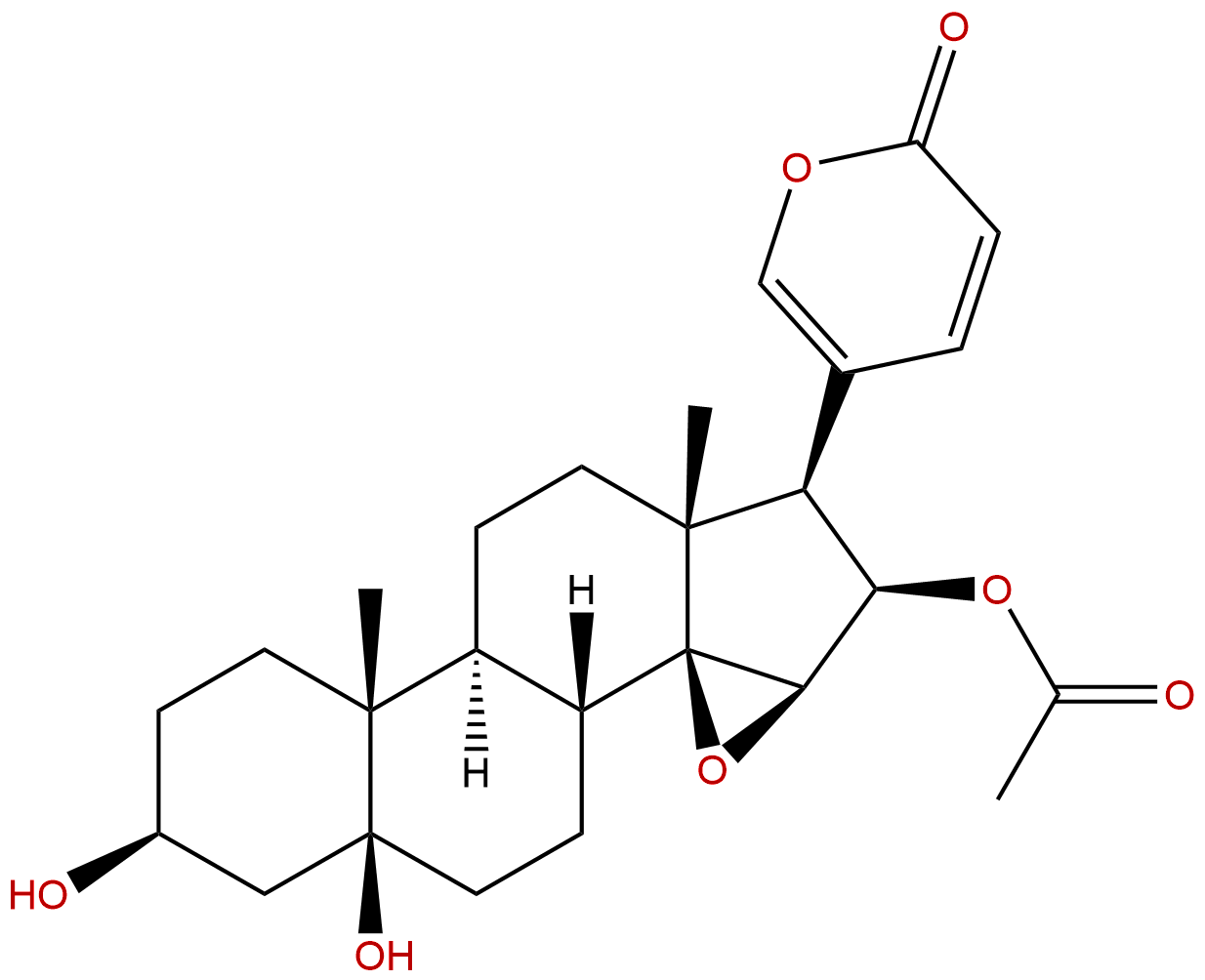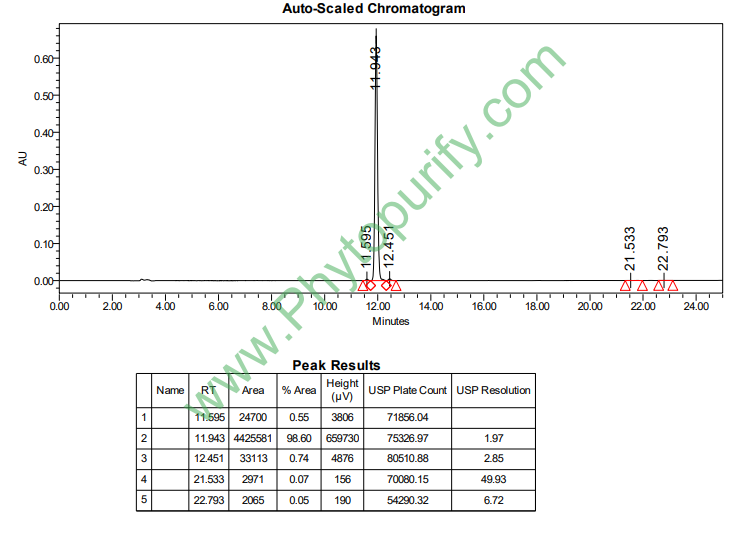
CinobufotalinCAS No.:1108-68-5
|
||||||||||
 |
|
|
||||||||

| Catalogue No.: | BP0367 |
| Formula: | C26H34O7 |
| Mol Weight: | 458.551 |
Synonym name:
Catalogue No.: BP0367
Cas No.: 1108-68-5
Formula: C26H34O7
Mol Weight: 458.551
Botanical Source: Ch'an Su, the dried venom of Chinese toads
Purity: 95%~99%
Analysis Method: HPLC-DAD or/and HPLC-ELSD
Identification Method: Mass, NMR
Packing: Brown vial or HDPE plastic bottle
Can be supplied from milligrams to grams.
For Reference Standard and R&D, Not for Human Use Directly.
Inquire for bulk scale.
Description:
Cinobufotalin is a main cardiac toxin in toad, it is a novel anti-HCC agent, it induces growth inhibition and apoptosis in cultured HCC cells through ceramide production. Cinobufotalin is also an effective reversal agent for the multidrug resistance of tumors, it can reverse the adriamycin-resistance in Raji/ADR cells and the expression of P-gp and MRP-1 proteins. Cinobufotalin can promote the dendritic cells(DCs) derived from peripheral blood of patients with chronic hepatitis B to mature and effectively enhance its(the DCs') capabilities, therefore the treatment of cinobufotalin may potentiate the antiviral immunity of the patients with chronic hepatitis B(CHB).
References:
Tumour Biol. 2015 Feb 28.
Ceramide production mediates cinobufotalin-induced growth inhibition and apoptosis in cultured hepatocellular carcinoma cells.
Hepatocellular carcinoma (HCC) is a highly aggressive and lethal neoplasm with poor prognosis. The aim of this study is to investigate the anticancer activity of Cinobufotalin, a bufadienolide isolated from toad venom, in cultured HCC cells, and to study the underlying mechanisms.
METHODS AND RESULTS:
We found that Cinobufotalin (at nmol/L) significantly inhibited HCC cell growth and survival while inducing considerable cell apoptosis. Further, Cinobufotalin inhibited sphingosine kinase 1 (SphK1) activity and induced pro-apoptotic ceramide production. Ceramide synthase-1 small hairpin RNA (shRNA)-depletion inhibited Cinobufotalin-induced ceramide production and HCC cell apoptosis. On the other hand, the glucosylceramide synthase (GCS) inhibitor 1-phenyl-2-decanoylamino-3-morpholino-1-propanol (PDMP) facilitated Cinobufotalin-induced ceramide production and cell apoptosis. SphK1 inhibitor II (SKI-II), similar to Cinobufotalin, increased cellular ceramide level and promoted HCC cell apoptosis. Finally, we observed that Cinobufotalin inactivated Akt-S6K1 signaling in HepG2 cells, which was again inhibited by ceramide synthase-1 shRNA-depletion.
CONCLUSIONS:
In conclusion, the results of this study suggest that Cinobufotalin induces growth inhibition and apoptosis in cultured HCC cells through ceramide production. Cinobufotalin may be investigated as a novel anti-HCC agent.
Zhongguo Shi Yan Xue Ye Xue Za Zhi. 2014 Oct;22(5):1306-10.
[Reversal effect of cinobufacini on multidrug resistance of Raji/ADR cells and its mechanisms].
The aim of this study was to explore the reversing effect of cinobufacini on multidrug resistance of Raji/ADR cells and its mechanisms.
METHODS AND RESULTS:
The growth inhibitory rate, half inhibitory concentration (IC50), reversing multiples to adriamycin- resistance were detected by MTT, and the curve of growth inhibitory rate was drawn; the MDR-1 and MRP-1 gene transcription was determined by RT-PCR; the expressions of P-gp and MRP-1 proteins were assayed by Western blot and flow cytometry. The results showed that the inhibitory rates of cinobufacini on Raji and Raji/ADR cells at 72 h were 75.6% and 69.3% respectively, the IC50 were 3.9 mmol/L and 4.6 mmol/L without significant difference (P > 0.05). The reversing multiples to adriamycin-resistance were 255.7 multiples, the transcription of mdr-1 and mrp-1 genes and the expression of P-gp and MRP-1 proteins significantly decreased (P < 0.05) in Raji/ADR cells after the treatment with Cinobufotalin.
CONCLUSIONS:
It is concluded that Cinobufotalin can reverse the adriamycin-resistance in Raji/ADR cells and the expression of P-gp and MRP-1 proteins were down-regulated through the transcriptional pathway. The Cinobufotalin is an effective reversal agent for the multidrug resistance of tumors.
Life Sci. 1998;63(9):781-8.
Neutralization of cardiac toxins oleandrin, oleandrigenin, bufalin, and cinobufotalin by digibind: monitoring the effect by measuring free digitoxin concentrations.
Oleandrin plant poisoning is common in children and the plant extract is used in Chinese medicines. The toxicity is due to oleandrin and the deglycosylated metabolite oleandrigenin. Bufalin and Cinobufotalin (toad cardiac toxins) are also widely used in Chinese medicines like Chan SU, and Lu-Shen -WU. Severe toxicity from bufalin after consumption of toad soup has been reported.
METHODS AND RESULTS:
Taking advantage of structural similarities of these toxins with digitoxin, we demonstrated that these compounds can be rapidly detected in blood by the fluorescence polarization immunoassay for digitoxin. The cross reactivities of these compounds with digoxin assay were much lower. For example, when a drug free serum was supplemented with 10 microg/ml of oleandrin, we observed 127.7 ng/ml of digitoxin equivalent but only 2.4 ng/ml of digoxin equivalent concentration. Digibind neutralized all cardiac toxins studied as evidenced by significant fall of free concentrations. When aliquots of serum pool containing 50.0 microg/ml of oleandrin were supplemented with 0, 10.0, 25.0, 50.0, 100, and 200 microg/ml of digibind, the mean free concentrations were 30.6, 23.3, 16.0, 10.7, 7.8 and 5.5 microg/ml respectively. Similarly, with 50.0 microg/ml of oleandrigenin (total concentration: 36.2 ng/ml), the free concentration was 14.5 ng/ml digitoxin equivalent in the absence of digibind and 5.4 ng/ml in the presence of 200 microg/ml of digibind. In another specimen containing 500 ng/ml bufalin (total concentration: 156.9 ng/ml), the free concentration was 8.6 ng/ml in the absence of digibind and none detected in the presence of 100.0 microg/ml digibind.
CONCLUSIONS:
Because such neutralization may also occur in vivo, digibind may be useful in treating patients exposed to these toxins.
HPLC of Cinobufotalin
